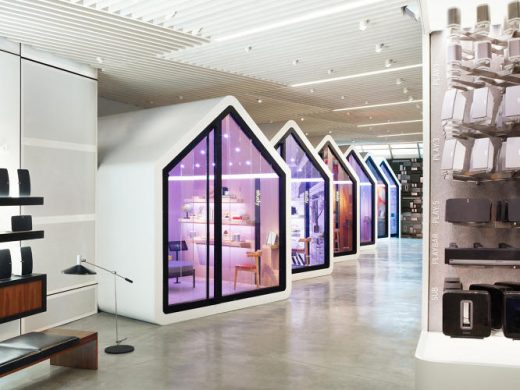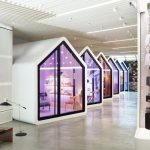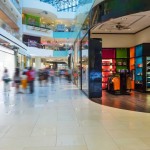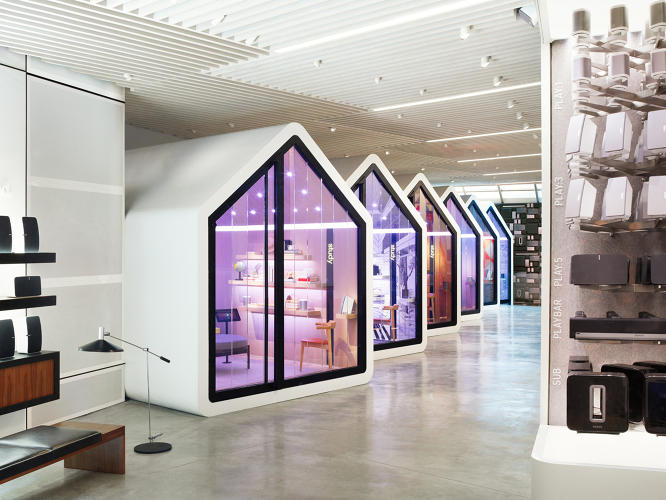Sonos Designed Its New Store To Feel–And Sound–Like Your Home
There’s something very weird about the empty store I’m standing in. It’s not that it’s nearly abandoned (in the middle of the bustling SoHo neighborhood in New York, no less) or that the finishing touches are still being fine-tuned in front of me. What’s strange is that it hasn’t existed until now.
That’s because Sonos, the high-fidelity smart speaker company opening this sleek, Apple-esque shop on Greene Street in SoHo, sells products that you need to experience to fully understand. When the Sonos store officially opens its doors on July 19, the Santa Barbara-based company is hoping that all this extra overhead and effort pays off in exactly that fashion: convincing people that spending several hundred dollars on a smart speaker system is worth it.
“It’s a very unusual experience,” says Dmitri Siegel, vice president of global brand and executive creative director for Sonos. “We’ve devoted almost all of the floor plan to these listening rooms. You’ll be able to go in there with whoever you come in with, and we’re going to leave you alone and let you listen to music.”
For the unfamiliar, Sonos makes a handful of different Wi-Fi-connected, high-fidelity speakers that can be linked together to create an immersive, multi-room listening experience. It’s sort of like your friend’s portable Bluetooth speaker, but without the portability or the Bluetooth. Instead, Sonos is designed to be used in the home or office and relies on Wi-Fi (along with its own proprietary smartphone software) to pump music throughout whichever parts of the building you’ve decided should have a soundtrack. One can start simple with the compact $200 Play:1 speaker, splurge for the higher-power Play:3, Play:5, or their home theater sound bar. Or hey, go crazy, and drop a few grand and string a bunch of them together. YOLO.

While it’s possible to hear a Sonos speaker in a store like Best Buy or Target, it doesn’t quite capture anything resembling the experience you would have at home, because until something truly borderline apocalyptic happens, you don’t live inside an abandoned big-box retail store. The shape and acoustics of your home are very, very different from that of a Target.
For that reason, Siegel and the Sonos team, with some outside help, designed a space that is made to feel—and sound—more like a home than a store. Indeed, when you walk into the fairly minimalist, two-story retail space, you won’t see a row of cash registers with lines of people flowing from them. Instead, after walking by the enormous portrait of famed record producer (and Sonos board member) Rick Rubin on the wall, you’ll see a row of seven listening rooms, each one sonically isolated from the outside world with a steel-framed door made of thick, beveled glass. Inside each of the rooms—which are separated from one another by multiple layers of acoustic sheet rock—are comfortable furniture, bookshelves, knickknacks, and design details meant to make prospective customers feel right at home, even if most of us don’t live in homes that look like we went on a high-end Etsy shopping spree with an interior design snob. Oh, and there are speakers, of course.
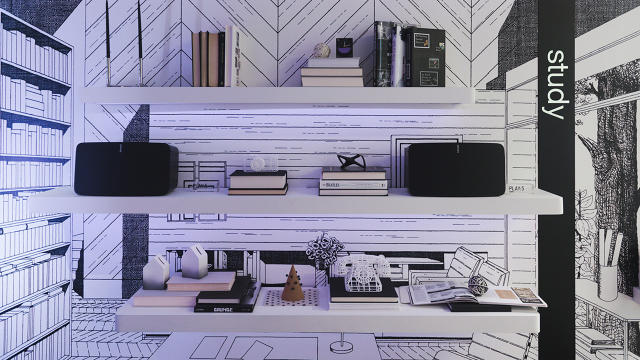
After a brief introductory video, visitors are encouraged to play around with the Sonos software and queue up the music they love, alternating between different combinations of speakers to hear what each sounds like. And the team has gone to great lengths to ensure the results are as pleasing as possible. These rooms have been acoustically designed with, for instance, walls that absorb and reflect sound in just the right way. Even the books are placed strategically—some of them with the spines facing inward on the shelf—to squeeze every last drop of potential sound quality from the rooms. Sonos’s “sound experience leader” Giles Martin—the record producer best known for taking up the mantle from his famous father, George Martin, in remastering The Beatles’ music—worked closely with Hilmar Lehnert, the company’s head audio engineer, to translate the physical details of each room into the best possible sonic results.
Of course, most people’s homes are not acoustically tuned by world-class engineers, but it’s not as though a Play:5 or Play:1 is going to sound like a trash can once it gets back to your home. Still, it’s worth keeping in mind that results may vary once a customer gets their speakers home.
Sound isn’t the only sensory detail obsessively perfected by the store’s designers, although it is the biggest one. Adorning the walls of the store are artifacts that nod to chapters of New York’s musical history. Upstairs, you’ll find a collection of rare music zines from archivist Arthur Fournier. Downstairs, there’s a glass-encased sampling of mixtapes from the personal collection of Sonic Youth’s Thurston Moore. In one of the listening rooms, a wall-sized mural by longtime Village Voice illustrator Mark Stamaty recreates the crowded chaos of SoHo in cartoon form.
If it sounds like Sonos obsessed over every last detail of the store, it’s because they did. As a company with rigorous hardware design planted firmly in its DNA, the company spent a long time—probably longer than they expected—crafting a physical experience that’s much bigger and more nuanced than a speaker that sits on the shelf. For several months, the company operated a secret store prototype in Carson, California, where it build several iterations of the store’s design and ushered in user experience researchers and focus groups to help them figure out how to build a retail environment that’s anything but conventional.
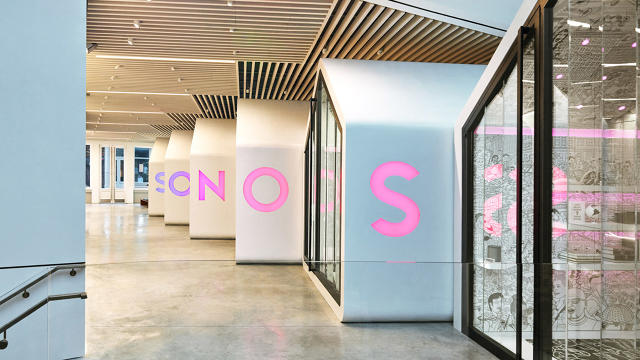
Indeed, as Siegel tells me, the store’s goal isn’t to see as many units flow out the front door as possible. “We know it can be a long buying decision-making process,” says Siegel. “It’s not generally a spontaneous purchase.” To that end, the kiosks in the listening rooms allow customers to email themselves details about the speakers so they can do more research at home later.
The store isn’t even expected to drive a huge, short-term boost in sales, necessarily. That would be a welcome outcome, of course, but the company sees plenty of other value in what they just built. For starters, it’s great for R&D. “We’re going to take what we learn from Greene Street and use it to inform us everywhere we show up, from our studio in London to Best Buy.”
With its store set to open its doors, Sonos can now turn its attention to other pressing matters. The unexpected success of voice-controlled smart speakers like Amazon Echo (and upcoming counterparts from Google and, as rumor has it, Apple) clearly caught Sonos off-guard. While the first iteration of the Echo doesn’t sound nearly as good as Sonos or allow synced, multi-room playback, the use of voice control is a user interface shift that Sonos knows it needs to embrace and is now reportedly working on integrating voice control into its products. Software is another challenge: As beloved as its hardware is by many Sonos diehards, its proprietary app for controlling music playback has grown stale and seldom gets much love. Presumably, a redesign of its software is on the list of projects to tackle next. But for now, the company has plenty of work to do in SoHo.
related video: Rebecca Minkoff’s Store Of The Future Will Blow Your Mind
The Sonos store in New York City, the smart speaker company’s first retail outlet, opens on July 19.

Visitors to the Sonos store are greeted by a huge mural of famed record producer (and Sonos advisor) Rick Rubin.
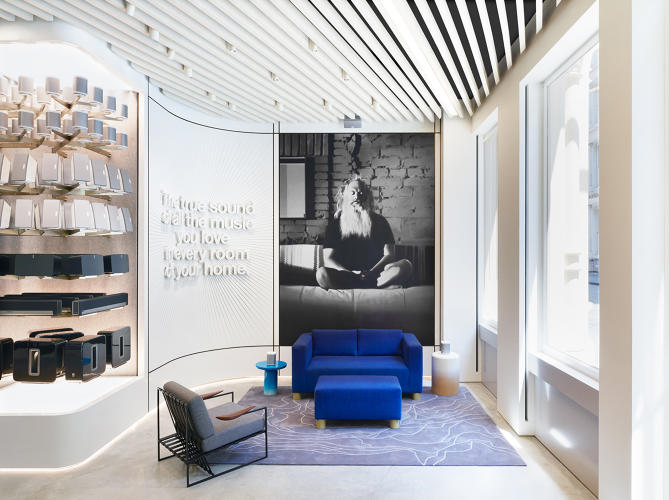
One of the seven listening rooms found in the Sonos store in SoHo.

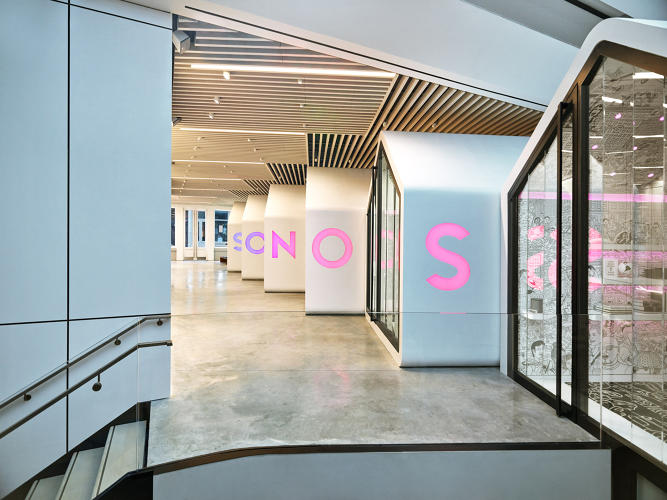
Mixtapes from the personal collection of Sonic Youth’s Thurston Moore adorn the wall downstairs in the Sonos store.
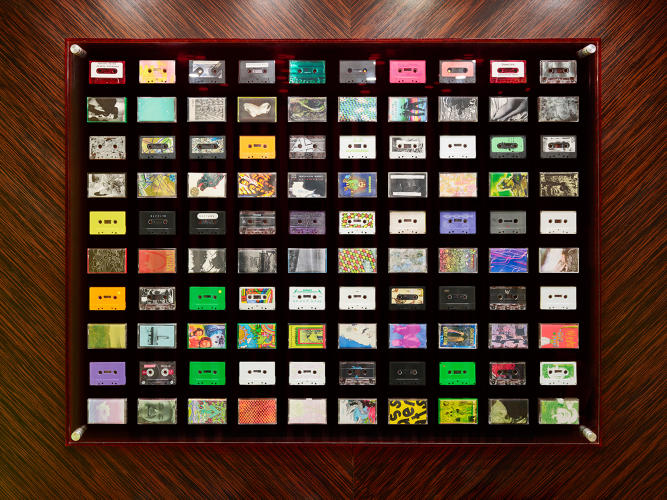
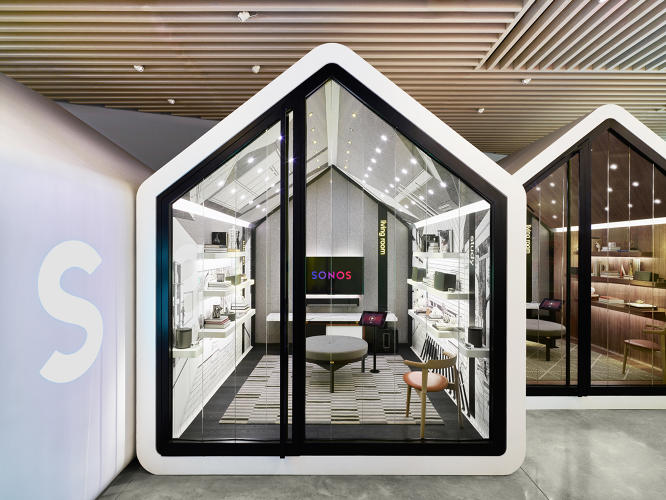

Fast Company , Read Full Story
(56)

